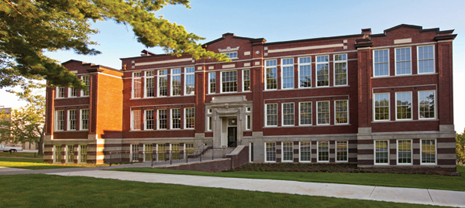
FAYETTEVILLE, Ark. – The restoration of Peabody Hall on the University of Arkansas campus earned an award from the Historic Preservation Alliance of Arkansas, recognizing it as a project that retains the "significant historic fabric" of the building.
Planners who worked on the restoration wanted to preserve some aspects of the original structure built in 1913. They also needed to create a modern academic facility to better serve the students and faculty and the schools that hire the education graduates.
These planners – including officials of the University of Arkansas and College of Education and Health Professions, architects and contractors – were honored for their work Friday, Jan. 13, with the award for Excellence in Preservation through Rehabilitation. The Historic Preservation Alliance of Arkansas presented annual awards for 13 projects across the state at an event in Little Rock.
“An important part of fostering a vibrant local economy includes preserving and revitalizing historic areas and structures, which often represent the foundations of our communities,” said Vanessa McKuin, executive director of the alliance. “By maintaining and restoring these areas, we are investing in the economic vitality and sense of community that make our towns and cities across the state special places to live.”
Allison Architects of Fayetteville was the lead architect on the project with assistance from Schwartz/Silver Architects of Boston, a firm that specializes in historic restorations. East-Harding of Little Rock was the general contractor.
Last fall, Chancellor G. David Gearhart opened his welcoming address to campus with a walk through Peabody Hall. He used the word “phenomenal” to describe the work done to restore “a historic and much-loved campus icon.”
Mike Johnson, associate vice chancellor for facilities, said the university community is extremely proud of the project.
“We have been pleased and excited at the reaction of literally hundreds of former students and faculty that have been able to come back and walk through the building, recalling fond memories of past days,” Johnson said. “The Arkansas Historic Preservation Alliance award to the university and our superb design/construction team just adds to the luster of this wonderful educational facility reassuming its pivotal role on our proud campus.”
More than 300 people attended a re-opening celebration in November, including many who were students at the training school operated for more than 50 years in Peabody Hall. They reminisced with former classmates and toured the building to recall where they visited the school library, studied and took part in school activities. Retired dentist Calvin Bain of Bella Vista had not been back since his graduation from University High School almost 70 years earlier.
“I love history and historic buildings and structures and stories so it’s quite pleasing to me that it has been restored,” Bain said.
Designed by architect L.J. Roberts, the building is named in honor of George Peabody, whose Peabody Education Fund helped to finance construction with a $40,000 gift, the first private contribution to the university. Peabody Hall originally housed – and still houses – the teacher-education programs at the university. It is home to the curriculum and instruction department in the College of Education and Health Professions.
Red brick, Carthage stone trim, a clay tile roof and abundant windows characterize the exterior of Peabody Hall. In an attempt to visually unify the campus character during the 1940s, Peabody Hall was painted a light cream color in order to blend with the limestone Collegiate Gothic buildings proposed by the university’s 1925 Master Plan. The cementitious paint application trapped moisture within the building, causing severe damage to the interior, and it also obscured the significant masonry detail of the building. The original wood windows had also been replaced with vinyl windows. Along with the paint application, the proportions of the windows created a discordant exterior appearance.
Key goals during the rehabilitation of Peabody Hall included restoring the original exterior character of the building by removing the paint; replacing damaged and deteriorated flashings, roof membranes and clay tiles; re-pointing the brickwork with lime putty mortar; and replacing the residential-quality vinyl windows with aluminum-clad double-hung windows that match the original 6-over-6 glazing and muntin patterns.
Key historic components such as the original pine flooring and stamped metal ceiling tiles were salvaged and reused in the building. Light fixtures and furnishing appropriate to the original Peabody Hall were also incorporated in the rooms in the “historic zone.”
State-of-the-art teaching equipment and updated mechanical and electrical systems were incorporated into the building. In order to maintain the high ceilings – a defining architectural characteristic of the building – an innovative chilled beam mechanical system was utilized, reducing the need for in-ceiling ducting.
Contacts
Heidi Wells, content writer and strategist
Global Campus
479-879-8760,
heidiw@uark.edu